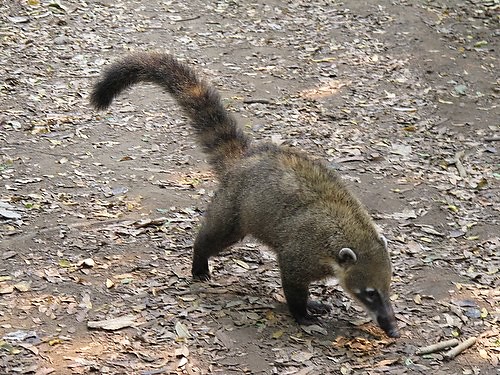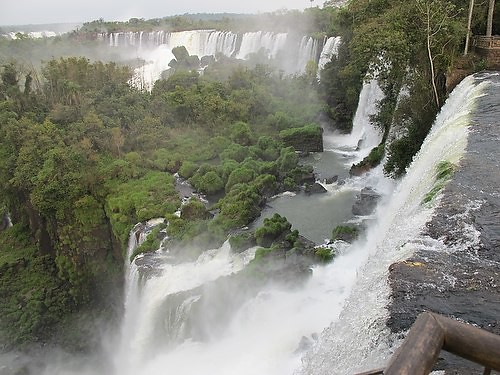IGUAZU FALLS NATIONAL PARK – Agoutis and coaties, monkeys and toucans and brilliant morpho butterflies blessed my path in this jungle wonderland, as did a brightly colored bird whose name in Guarani means “grandchild of the rainbow.”
These waterfalls are famous the world over but are known mainly in the United States for their starring role in Robert De Niro and Jeremy Irons’ classic film The Mission. I’d dreamed of coming here for years; its majesty dwarfs the mighty Niagra, and the natural beauty of its jungle habitat bids one to linger.
I arrived first thing in the morning but waited to see the falls, choosing instead to integrate myself into the natural surroundings first. I started with a seven-kilometer hike through the jungle on the Macuco Trail, named for a reclusive, chubby brown land-dwelling bird that lives in these parts.
The jungle is best visited in the early morning, when the birds and animals are still at their most active. The insects clacking and chirping in the trees are overwhelming in themselves; the trail winds through vine- and moss-draped trees and groves of bamboo. I hadn’t been on the trail more than five minutes when a family of coatimundis ambled across my path, snuffling under leaves and bark in search of juicy ants and other insects.

Further along I heard a crow-like raspy croaking and moved forward silently, hoping the sound was what I thought it might be. Sure enough, in the opening of tree canopy ahead of me I saw the back bird arch through the sky, its brightly striped beak pointing the way – a toucan, incredibly graceful in flight. Before I’d only seen this odd-looking creature preening itself in captivity. This elegant creature arrowing through the skies was like a different animal entirely.
Butterflies of all colors floated and flitted across my path; the star of the show was the glittery, metallic blue Morpho, and I was entranced when a baby one lighted on my knee. But they came in all colors, shapes and sizes: orange and yellow, black and gold, and a little black, white and read one called “ochenta y ocho” because of the figure of an 8 on each wing.
Further along a family of spider monkeys was making its way from treetop to treetop, gathering fruits before swinging from branch to branch with almost the same careless grace as those butterflies.
Finally the trail led to the first waterfall – a tiny preview of what I would soon see, but dramatic in its own right, falling as it did into a tranquil blue pool from some 20 meters above.
Now it was time for the long-awaited first glimpse of this natural wonder. I say first glimpse because seeing the falls in their entirety is a project that requires a couple of days and a border crossing, but I began, as most do, by catching the Jungle Train to the stunning spectacle of the Garganta del Diablo, or Devil’s Throat.
This involves a kilometer-long hike over the river on steel walkways suspended from island to island. One hears the roar long before the first set of falls becomes visible; when the trees of the last island open to reveal the blue-and-white Argentine flag flapping in the breeze, a mighty roar overwhelms the senses and the spray of a thousand centuries dampens the skin. Elated tourists take turns soaking in the majesty of the moment and posing in front of the spectacular backdrop.
Iguazú, whose original Guaraní inhabitants named it “Great Water,” encompasses more than 275 separate waterfalls spread like tiers of a vast wedding cake over some two miles of river, and was created by a volcanic eruption that left an enormous crack in the earth.
These facts are presented on the tourist brochures and in the guides, but nothing can explain the feeling of coming face to face with this marvel. Upon her visit, Eleanor Roosevelt was said to have uttered the words, “Poor Niagra!”
Susana, an Argentine woman in her 70s, had been there 14 years before, and had always wanted to return. Upon filling her eyes with the sight, she wept. “I still can’t believe it,” she said.
A series of hikes and boating expeditions to see various parts of the falls from different angles on the Argentine side alone can easily occupy two days. I took an eco-boating tour with a nature guide who led us to crocodiles, cormorants and a colorful bird whose Guaraní name means “grandchild of the rainbow.” By way of contrast, I also took a speedboat ride right up into the falls, a good drenching best accompanied by a good bit of screaming.
Most choose to see the falls from the Brazilian side, as well – an option that is out of my budget range because of my U.S. citizenship. Because of the high cost of a U.S. visa, Brazil decided a few years back to return the favor and now charges U.S. tourists $130 for a 90-day visa. I decided to forego the Brazilian view with no regrets. The bulk of the national park is on the Argentine side, where there is closer access to the actual falls, while the Brazilian side offers panoramic views and helicopter rides.
Argentina has discontinued the helicopter rides, our guide tells us, because the vibrations were found to be damaging the eggs of toucans and other nesting birds. He hastened to add that Brazil has passed a law requiring tour operators to keep a certain distance from the treetops.
Some places defy description; This is one of them. I can only suggest that you add this to your lifetime “must see” list.
Iguazu Falls is under consideration in the current world vote for the Seven Wonders of the Natural World. They have my vote, and you can vote too at the official Seven Wonders website.
Created with Admarket’s flickrSLiDR.

Hola Tracy! Te felicito por las fotos que has tomado, estan espectaculares! Yo las he visitado, hace muchos años, deberia ir de vuelta. Me siento orgullosa porque por fin aparentemente la mano del hombre no hizo de las suyas y se mantiene bastante “wild” todo el paisaje,
Segui disfrutando!! Besos
What a beautiful photo up top!!